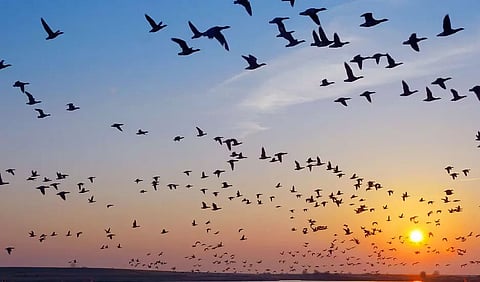
- Home
- Live Blog
- Breaking News
- Top Headlines
- Cities
- NE News
- Sentinel Media
- Sports
- Education
- Jobs

The arrival of Amur Falcons and other migratory birds in millions in India’s northeast region is also a reminder for prioritizing conservation of the habitats of these winged visitors in this part of the Central Asian Flyway (CAF). Building awareness about food, shelter, and the nesting of migratory birds can help communities play a crucial role in the conservation of wetland, grasslands, and forests in the region for sustainable avian migration. Apart from sighting in natural landscapes being a feast for eyes for any nature lover, the science of long-distance migration and how they remember the pathway for the return journey is always fascinating for ornithologists and bird watchers. More importantly, they are also indicators of the ecological health of an area. While regular arrivals and a steady population of migratory birds indicate ecologically sound habitat, dwindling populations or diversion to a new site indicate ecological degradation. Amur Falcons travel up to 22,000 km in a year from south-eastern Siberia and Northern China and arrive in the region in October en route to their destination in South Africa. Dissemination of these interesting facts has added attraction to the roosting sites of the raptor in Nagaland, Manipur, and the Dima Hasao district in Assam, and these sites are now included in the itineraries of eco-tourists visiting the northeast region. It has also helped build awareness among local communities in those areas where earlier Amur Falcons or other migratory birds were killed for meat to prohibit the killing of these birds and undertake community initiatives for conservation of their habitats. The conservation success stories have encouraged more eco-tourists and wildlife enthusiasts to visit these sites, boosting tourism in the region. Fragmentation of wildlife habitat, encroachment of wetlands, siltation reducing the depth of water, pollution, etc. have added to the challenges of conservation of the habitat of migratory birds. The ‘National Action Plan for Conservation of Migratory Birds along the Central Asian Flyway’ launched in November 2018 emphasises coordination and cooperation between various Central Government Ministries, State Government Departments, managers of protected areas, local communities, civil society, and the private sector. The Action Plan prioritizes 48 important migratory water bird sites and 31 important migratory land bird sites spread across 17 states for conservation. India is a signatory to the Convention of Migratory Species, the environmental treaty under the United Nations Environmental Programme signed in 1979. The country being a core area of CAF, the National Action Plan envisions the country becoming the nerve centre of the flyway. Key objectives of the plan include reducing and halting the decline in the population of migratory birds, reducing pressure on critical habitats through the adoption of landscape-based management, strengthening databases to improve decision-making and science-based conservation of species and management of habitats, sensitising stakeholders for collaborative actions to secure habitats, and fostering trans-boundary cooperation to secure migratory birds and habitats in range countries. This being the terminal year of the five-year action plan, a comprehensive review of the achievements and challenges will help experts formulate a long-term action plan to sustain the conservation success story. Degradation of catchment areas, aggravation of the erosion problem of the River Brahmaputra, erratic rainfall due to climate change impacts, and industrial activities have increased the ecosystem vulnerability of the wetlands along the floodplains of the mighty river. Conservation of the habitat of migratory birds in the state is not possible in isolation without a holistic approach to conservation of the entire river ecosystem. Upgrading the legal protection of wetland is essential, particularly for wetland outside protected areas. Educating local communities about the ecological significance for conservation and breeding of fish and other important aquatic species for economic gain and conservation of resident and migratory water birds will prevent filling up these for the construction of buildings and other infrastructure. Protection of these sites for eco-tourism activities will strengthen the local economy, whose potential will be lost forever if these wetlands are treated as wastelands and converted to a construction site. Designating more wetlands in the region as Ramsar sites will go a long way towards bolstering community and government initiatives for wetland conservation. Putting in place scientific and sustainable solid and liquid waste management in the cities and villages with wetlands and other important bird habitats is of paramount importance to achieving the objectives of the national action plan. Guwahati city, with over a million people not having a single sewage treatment plant, speaks volumes about the status of conservation of the only Ramsar site in the state—Deepor Beel. As multiple entry points of the wetland remain open for discharge of sewage water and effluent from the capital city, the ecosystem of this important habitat is adversely affected, posing a conservation threat to this habitat of migratory and resident birds. The persistence of such problems ever since the launch of the National Action Plan reflects gaps in planning and execution. Conservation of wetland for migratory birds has the double benefit of releasing clean water into the landscape.